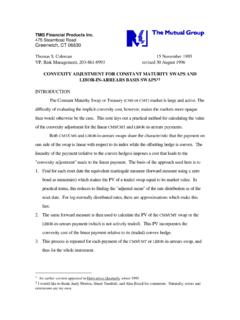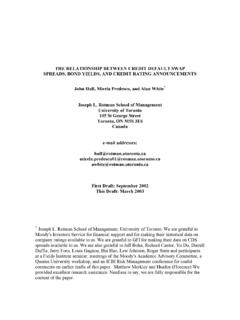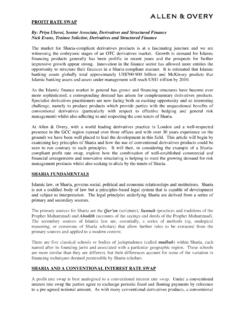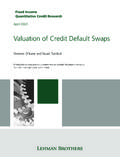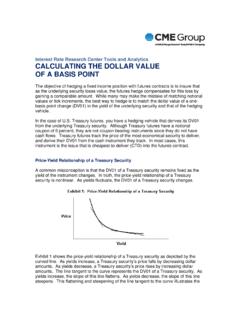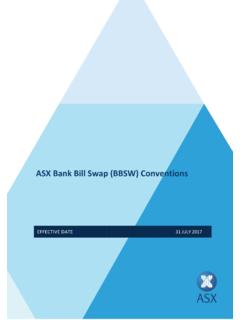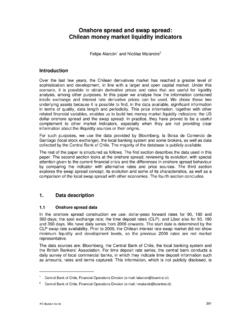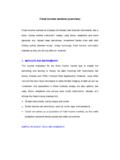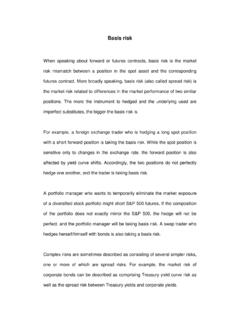Transcription of Interest Rate Parity - Bukkapatanam
1 Interest Rate Parity ,Money Market basis Swaps, andCross-Currency basis SwapsBecause the classic Interest rate Parity condition requires default-free rates as input, the common practice ofusing rates derived from swap curves is not valid. This paper derives Interest rate Parity conditions that depend onbasis swap spreads in addition to swap Tuckman, Pedro PorfirioFixed IncomeLiquid Markets ResearchJune 2003 CONTACTS Editors Hua He Vasant Naik .. Bruce Quantitative Strategies (Europe) Vasant Naik .. Matt David Mendez-Vives Interest Rate Modelling ( ) Bruce Fei Zhou .. Quantitative Research (Asia) Hua He Charles W.
2 Liu .. Manabu Matsumoto FX Research Jim Alexei Anne Shruti Additional Contacts Amitabh Ganlin Marco Lehman Brothers | LMR Quarterly LMR Quarterly, vol. 2004-Q2 June 2003 2 Please see important analyst certifications at the end of this report. Interest Rate Parity , Money Market basis Swaps, and Cross-Currency basis Swaps Because the classic Interest rate Parity condition requires default-free rates as input, the common practice of using rates derived from swap curves is not valid. This paper derives Interest rate Parity conditions that depend on basis swap spreads in addition to swap rates .
3 The derivations reveal: i) the relatively well accepted proposition that money market basis swaps reflect the credit risk inherent in one floating rate versus another; and ii) the less known proposition that cross-currency basis swaps reflect the difference between the credit risk embedded in the short-term rates of one currency versus the other. Several empirical examples are given in support of this less known proposition. 1 1. CLASSIC Interest RATE Parity Interest rate Parity is an arbitrage argument used to derive forward foreign exchange rates . To describe the classic form of this argument, define the following variables: 0S: Spot exchange rate of dollars per unit of foreign currency.
4 Y: T-year default-free dollar spot (ie, zero-coupon) rate of Interest . y%: T-year default-free foreign spot (ie, zero-coupon) rate of Interest . F: Forward exchange rate of dollars per unit foreign currency for delivery in T years. Now consider the following table of today s transactions (Figure 1). It is assumed throughout that there is no counterparty default risk in forward or swap contracts. 2 Figure 1. The arbitrage argument for classic Interest rate Parity Transaction Today($) Time T ($) Today (Fgn) Time T (Fgn) Borrow 0 Sdollars 0S+ ()01 TSy + Sell0 Sdollars, buy foreign 0S +1 Invest foreign -1 ()1Ty+% Sell foreign forward ()1 TFy++% ()
5 1Ty +% Total 0 0 0 1 The authors thank Fredrik Akesson, Dev Joneja, Jean Paul Paradis, and Fei Zhou for helpful comments and suggestions. Pedro Porfirio works on the FX Trading Desk. 2 Counterparty default risk is largely mitigated by the financial soundness of the entities involved, by requirements to post collateral based on changing market values, and by the imposition of credit lines. Bruce Tuckman 212-526-2252 Pedro Porfirio 212-526-7964 Lehman Brothers | LMR Quarterly Reprinted from the LMR Quarterly, vol.
6 2004-Q2 March 2004 3 Because these transactions neither generate nor require cash today, ruling out arbitrage requires that they neither generate nor require cash at time T either. Mathematically, () ()0110 TTSyFy +++=% (1) Solving for the forward price, ()()011 TTyFSy+=+% (2) The problem with applying this classic argument in practice is that market participants observe spot rates implied from swap rates , not default-free spot rates .
7 Because swap rates are fixed rates that are fair against 3-month LIBOR, which has a built-in credit premium, spot rates derived from swap rates are too high to be used in equation (2). The following section describes how money market basis swaps link rates containing different credit premiums. 2. MONEY MARKET basis SWAPS A money market basis swap is an exchange of floating rate payments based on one index for floating rate payments based on another index. Liquid examples include: Fed Funds vs. 3-month LIBOR; T-Bills vs. 3-month LIBOR; 1-month vs. 3-month LIBOR; 1-month vs.
8 6-month LIBOR; and 3-month vs. 6-month LIBOR. Taking one example a bit further, on March 4, 2003, a trader might have agreed to exchange 1-month LIBOR plus basis points monthly for 6-month LIBOR semiannually for three years. Consider an imaginary basis swap to exchange the default-free rate of one term for the default-free rate of another term, eg, to exchange the default-free 1-month rate monthly for the default-free 3-month rate quarterly. Appendix 1 shows that this and all similar swaps should trade flat. Intuitively, the definition of the term structure of default-free rates is precisely that borrowers and lenders are indifferent between 1-month money rolled over a quarter and 3-month money.
9 Unlike these imaginary swaps of default-free rates , observed money market basis swaps exchange rates with a built-in credit premium. Furthermore, the credit premium built into a particular rate index differs from that built into another. For example, the credit risk of a 3-month loan is greater than that of rolling over 1-month loans for a quarter. Hence, to clear markets, 3-month LIBOR must be set such that its certain receipt, ie, its receipt with no possibility of default, has greater value than the certain receipt of 1-month LIBOR over the corresponding quarter.
10 Hence, in a basis swap without any counterparty default risk, 1-month LIBOR plus a spread is fair against 3-month LIBOR. It is important to distinguish between the pricing of loans made at the index rate and the pricing of basis swaps. The credit characteristics of Corporation A might be such that it fairly borrows at 1-month LIBOR. Similarly, the credit characteristics of Corporation B might be such that it fairly borrows at 3-month LIBOR. Nevertheless, as argued in the previous paragraph, parties to a swap with no counterparty default risk willingly exchange 1-month LIBOR plus a spread versus 3-month LIBOR.
